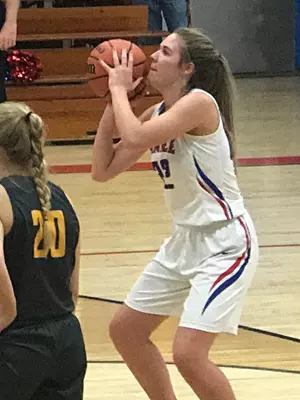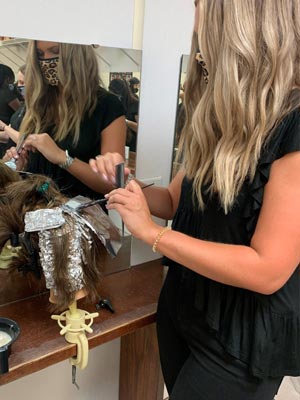- Home
- Patient Stories
- Peroneal Neuropathy - Hanna Adcock
A team approach to care helps young patient regain use of leg and foot after nerve surgery
Written by: Crystal Huff
 During her junior year of high school, Hanna Adcock was playing in a winter-holiday basketball tournament. After taking a shot, she came down and twisted her right knee. Officials at the game thought she might have torn her ACL, so she was put in a knee immobilizer. Four days later, an MRI showed no tear, but she started having numbness from her knee down to her toes. Hanna began falling a lot because her leg would go completely numb.
During her junior year of high school, Hanna Adcock was playing in a winter-holiday basketball tournament. After taking a shot, she came down and twisted her right knee. Officials at the game thought she might have torn her ACL, so she was put in a knee immobilizer. Four days later, an MRI showed no tear, but she started having numbness from her knee down to her toes. Hanna began falling a lot because her leg would go completely numb.
Hanna saw a local orthopedic surgeon in her hometown of Rochester, Illinois. Hanna says, “He told me he believed I had a nerve entrapment behind my hamstring and that I needed surgery.”
After that surgery, her symptoms improved and she seemed to be on the track to recovery.
Hanna recalls, “About six to eight weeks later, I lost all function in my foot. I was not able to move my foot and developed a drop foot, where it’s difficult to lift your foot to walk. I had no hot or cold sensation.”
Hanna then saw a neurologist and had an electromyography (EMG) test, which came back completely normal. The neurologist then suggested she have a brain scan. Hanna says, “I was frustrated and I knew it was not my brain. I then asked for a referral to Washington University Orthopedics at Barnes-Jewish Hospital in St. Louis.”
Over a year after her initial injury, Hanna saw Washington University Orthopedics nerve injury specialists Christopher Dy, MD, MPH — a hand surgeon who specializes in upper and lower extremities, and Dale Colorado, DO — a physical medicine and rehabilitation physician. Drs. Dy and Colorado are team members of the Multidisciplinary Complex Nerve Clinic, a unique program that brings together physicians from multiple specialties with expertise in treating nerve injuries. A second EMG was performed and this time it showed she had severe nerve damage from her knee to her foot. She was scheduled for a peroneal nerve decompression and neurolysis surgery.
According to Dr. Colorado, “Sometimes patients have had prior EMG studies that return normal. However, if we have high clinical suspicion for a nerve disorder, it can be worthwhile to repeat the testing in greater depth. This might include using neuromuscular ultrasound, testing more/different muscles or checking for more subtle side-to-side differences.”

Dr. Dy explains, “The updated nerve study from Dr. Colorado confirmed the suspected nerve damage, allowing me and Hanna to proceed to surgery with confidence that we could help her. Releasing Hanna’s nerve from scar tissue provided a near-immediate improvement, showing the power of having collaborative relationships and a team approach.”
Hanna says, “I am so thankful that Dr. Dy listened to me after being dismissed by previous doctors. As soon as I woke up from surgery I was able to move my toes again.”
She wore a cast for two weeks and then a moved to a boot to relearn how to walk.
She quickly returned to working out and was able to start running again. Within a few months, Hanna had full control and feeling back in her right foot and lower leg.
Hanna believes the surgery helped her follow her dream of being a cosmetologist. During her junior year of high school, she began after-school training in cosmetology classes. “I wouldn’t have been able to do that since I have to stand on my feet all day. I am only 18 years old and Dr. Dy completely saved my life. If I hadn’t met him I have no idea what would have happened and would have had to live the rest of my life without the use of my right foot.”